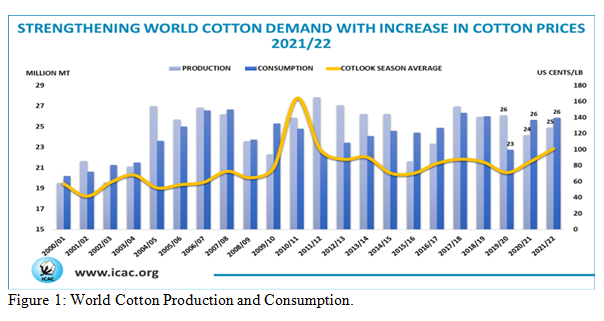
Dr. Md. Gazi Golam Mortuza:07th October 2022, World Cotton Day is observed to celebrate the global importance and significance of cotton. Cotton is grown in over 75 countries and traded worldwide. It’s a poverty-alleviating crop in some of the least developed countries in the world, providing sustainable and decent employment to people across the globe. It biodegrades quickly compared with synthetic alternatives, decreasing the amount of plastics entering our waterways and helping to keep our oceans clean. It’s the only agricultural commodity that provides both fiber and food. As a crop it grows in arid climates, it thrives in places no other crop can.
The objectives of the World Cotton Day 2022 are an opportunity to highlight its role in creating jobs and maintaining economic stability in least-developed countries (LDCs), aim to foster sustainable trade policies and to enable developing countries to benefit from every step of the cotton value chain.
Through the world cotton day 2022, we want to reach every stakeholder who is the key audiences such as producers, mills or manufacturers, brands or retailers, consumers, academicians, researchers, media personnel, NGOs and Government authorities. Producers increase production of cotton and influence planting choice, mills/manufacturers increase consumption of cotton and production of cotton goods, brands/retailers increase preference of cotton and influence sourcing decision, last of all consumers increase demands and preference for cotton. Academicians educate on the benefits and the value of cotton to creates positive perceptions, researchers encourage funding for research to promote continuous improvement and innovation in the cotton industry. Media dispel negative myths about cotton, NGOs educate and develop positive partnerships, and last but not least Government authorities support cotton friendly production and trade policies.
Cotton issue has been discussed in WTO agriculture negotiations and an important development-related issue since it was raised in 2003 by four African least-developed countries- Benin, Burkina Faso, Chad and Mali, which are known as the Cotton Four or C-4.
The decisions on cotton issue adopted at the Bali Conference 2013 and at Nairobi Ministerial Conference 2015 have given the importance that WTO Members attach to cotton.
The Cotton-4 nations of Benin, Chad, Mail, and Burkina Faso made an official proposal to the United Nations General Assembly (UNGA) for the establishment of World Cotton Day. One of the largest cotton organisations in the world, the Bremen Cotton Exchange, also supported the idea.
At first the WTO hosted the launch of World Cotton Day on 7 October 2019 following an initiative of the Cotton-4 countries. The event was organized by the WTO Secretariat in collaboration with the secretariats of the United Nations Food and Agriculture Organization (FAO), the United Nations Conference on Trade and Development (UNCTAD), the ITC and the International Cotton Advisory Committee (ICAC).
The United Nations General Assembly decision, on 30 August, to officially recognize 7 October as World Cotton Day as submitted by the Cotton- 4 countries. The UN resolution (A/RES/75/318) proclaiming World Cotton Day acknowledges and recognizes its broader economic and social impact around the world.
Cotton is widely grown and an important cash crop in the world as well as Bangladesh. Cotton is a soft and fluffy staple fiber. The fiber is almost pure cellulose. Cotton is cultivated in tropical and subtropical regions of more than seventy five countries of the world, on 33-35 million hectors in each year, which represents 2.5% of the all cultivated land. More than 100 million families are directly involved in cotton production and produced 25-26 million ton of raw cotton, where average lint production is about 800 kg per hectore. Cotton crop provides food and fibre. Cotton is the major textile fibre used by man in the world and playing a key role in economic and social welfare.
It is grown primarily as a fibre crop, but after the lint, the long twisted unicellular hairs are removed by ginning, the seed can be crushed to extract vegetable oil and protein rich animal feed. More than 100 countries are involved in export and import of raw cotton. It provides food, animal feed, fibre and fuel. It sustained millions of people for their livelihood at farms, ginning factories, textile mills, edible oil and soap industry etc.

More than 50 million tons of cottonseed is produced in every year in the world. Cottonseed is an important source of oil seed. It can be used as feed for livestock or fish. Cottonseed can be crushed in oil mill to get oil, hulls, meal and linters.
From the ancient time, the finest cotton fabric- Moslin once produced in medieval Bengal was famous throughout the world. The cotton for producing Moslin was grown on high lands around Dhaka where most muslin handlooms were located.
The year 2009 was assigned the international year of natural fibres by the UN. Natural fibre industries employ millions of people all over the world, especially in the developing countries. As the major non-food commodity natural fibres and their products are processed in many small and large industries and consumers all over the world profit from the provided products.
Cotton is produced all over the world and one single tonne of cotton provides almost one year-round employment for five people on average. Cotton crop is perfectly suited for regions with an arid climate. Overall, cotton occupies just 2.1 percent of the world’s arable land and yet meets 27 percent need of the world’s textile sector. While cotton fibre is used in textiles and clothing apparel, food products like edible oil are obtained from cotton and its seed is used as animal feed.
Cotton is used by millions every single day across the world and the demand for cotton is expected to rise over the coming years. This hike in demand has increased the need for sustainable cotton. Ways to produce cotton while caring for the environment are at the forefront of conversations in the drive for sustainability.
Conventional cotton production currently accounts for 18 percent of worldwide pesticide use and producers of cotton are being poisoned by heavy pesticide use. Sustainable cotton production is the solution to these issues. It reduces the use of hazardous chemicals, uses less water, and reduces poverty for cotton farmers.
Cotton crop provides food, feed, fibre and fuel. It contributes in food security by increasing by purchasable power of the farmers. It creates income and employment which has significant impact on economic and social aspect. Cotton plays a key role in the national economy of different countries that is why it is called White Gold for many countries of the world.
Government and other policy makers should develop positive support to boost up the cotton production. World Cotton Day, 2022 is an opportunity to show the positive impact on cotton, which will continue to have in the future and convince the international community to join the celebration. It plays a vital role in the national economy of different countries since cotton benefits more than 100 million families in over 75 countries of the world. World Cotton Day serves as a key opportunity to spread knowledge and showcase cotton-related activities and products. So, World Cotton Day has an importance and significant role to all stakeholders on economic and social aspect.
References:
1. https://www.wto.org/english/tratop_e/agric_e/cbps_e.htm
2. https://www.worldcottonday.com/
3. https://www.un.org/en/observances/cotton-day
4. https://www.icac.org/Home/WorldCottonDay?MenuId=71
Writer:Project Director,
Expansion of Cotton Cultivation Project, Cotton Development Board





















